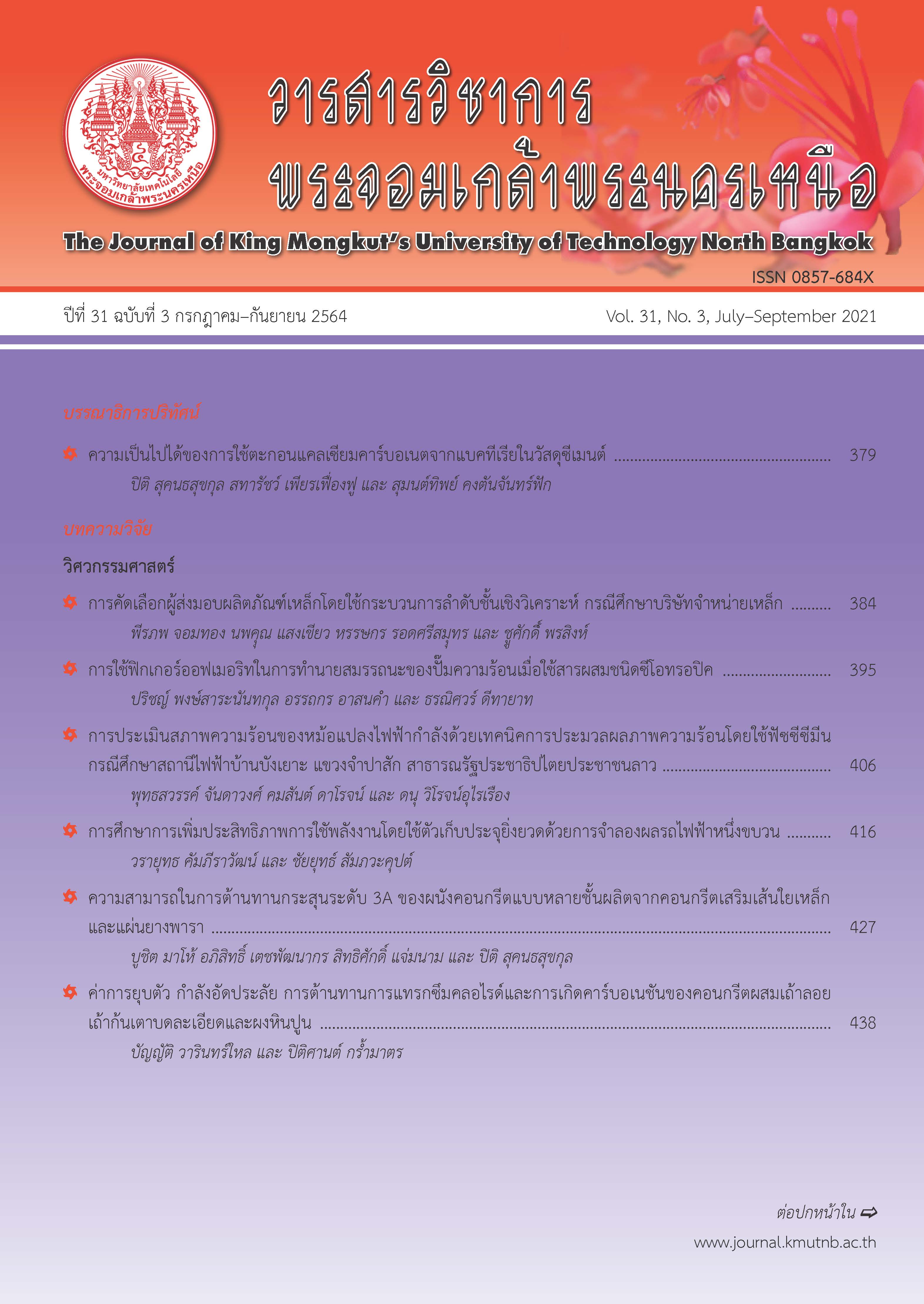การสร้างตัวแบบเพื่อทำนายผลสัมฤทธิ์ทางการศึกษาจากพฤติกรรมการใช้สมาร์ตโฟนด้วยเทคนิคการทำเหมืองข้อมูล
Main Article Content
บทคัดย่อ
งานวิจัยนี้มีวัตถุประสงค์เพื่อพัฒนาตัวแบบด้วยเทคนิคการทำเหมืองข้อมูลเพื่อนำมาใช้ในการทำนายผลสัมฤทธิ์ทางการศึกษาของนักศึกษาในหลักสูตรคอมพิวเตอร์จากพฤติกรรมการใช้สมาร์ทโฟน สำหรับการเก็บรวบรวมข้อมูลตัวอย่างใช้แบบสอบถามแบบออนไลน์เพื่อเก็บข้อมูลจากนักศึกษาระดับปริญญาตรี หลักสูตรทางคอมพิวเตอร์ จากมหาวิทยาลัยเทคโนโลยีพระจอมเกล้าพระนครเหนือ วิทยาเขตปราจีนบุรี และมหาวิทยาลัยเทคโนโลยีราชมงคลธัญบุรี จำนวนทั้งสิ้น 623 ตัวอย่าง และ 19 ปัจจัย ซึ่งชุดข้อมูลที่ได้เป็นชุดข้อมูลที่มีจำนวนตัวอย่างในแต่ละคลาสไม่สมดุลกัน ดังนั้นผู้วิจัยจึงเลือกเพิ่มข้อมูลตัวอย่างในคลาสน้อยด้วยขั้นตอนวิธี SMOTE และเปรียบเทียบประสิทธิภาพการจำแนกข้อมูลเพื่อสร้างตัวแบบทั้งสิ้น 5 ขั้นตอนวิธีประกอบไปด้วย ขั้นตอนวิธีต้นไม้ตัดสินใจ ขั้นตอนวิธีเพื่อนบ้านใกล้เคียง ขั้นตอนวิธีโครงข่ายประสาทเทียมแบบหลายชั้น ขั้นตอนวิธีการเรียนรู้แบบเบย์อย่างง่าย และ ขั้นตอนวิธีการสุ่มป่าไม้ โดยใช้เกณฑ์ในการประเมินประสิทธิภาพตัวแบบ 4 ตัว คือ ค่าความถูกต้อง ค่าความแม่นยำ ค่าความระลึก และค่าประสิทธิภาพ ซึ่งผลการทดลองพบว่า ขั้นตอนวิธีการสุ่มป่าไม้ มีความสามารถในการเรียนรู้ได้แม่นยำกว่าขั้นตอนวิธีอื่น ๆ ในทุกเกณฑ์ที่วัดประสิทธิภาพบนชุดข้อมูลได้ถูกปรับจำนวนตัวอย่างเรียบร้อยแล้ว โดยมีค่าความถูกต้องเท่ากับร้อยละ 78.04 นอกจากนั้นจากการศึกษาพบว่าปัจจัยพฤติกรรมส่วนบุคคลและพฤติกรรมการเล่นสมาร์ทโฟนที่ต่างกันจะมีผลต่อผลสัมฤทธิ์ทางการเรียนที่แตกต่างกันด้วย
Article Details
บทความที่ลงตีพิมพ์เป็นข้อคิดเห็นของผู้เขียนเท่านั้น
ผู้เขียนจะต้องเป็นผู้รับผิดชอบต่อผลทางกฎหมายใดๆ ที่อาจเกิดขึ้นจากบทความนั้น
เอกสารอ้างอิง
[2] P. Wongsafu, “Impacts of Internet using through a mobile phone of higher education students in Chiangmai province,” M.S. thesis, Art in Communications, Majoe University, 2014 (in Thai).
[3] D. Lupton. (2012, August). Digital Sociology: An Introduction. [Online]. Available:https://ses.library.usyd.edu.au/bitstream/handle/2123/8621/Digital?sequence=2
[4] L. Breiman, “Random forests,” Machine Learning, vol. 45, no. 1, pp. 5–32, 2001.
[5] N. V. Chawla, K. W. Bowyer, L. O. Hall, and W. P. Kegelmeyer, “SMOTE: Synthetic minority over-sampling technique,” Journal Artificial Intelligence Research, vol. 16, no. 1, pp. 321–357, 2002.
[6] J. Chareonrat, “Analysis on factors affecting normal-grade student dismissal using decision tree,” SNRU Journal of Science and Technology, vol. 8, no. 2, pp. 256–267, 2016 (in Thai).
[7] X. Zhang, R. Xue, B. Liu, W. Lu, and Y. Zhang, "Grade prediction of student academic performance with multiple classification models,” in Proceedings 2018 14th International Conference on Natural Computation, Fuzzy Systems and Knowledge Discovery (ICNC-FSKD), 2018. pp. 1086–1090.
[8] T. Chuangchai, “The student's learning style analysis on student's senior project by using data mining,” Journal of Graduate Studies Valaya Alongkorn Rajabhat University, vol. 10, no. 2, pp. 53–62, 2016 (in Thai).
[9] A. Sonak, R. Patankar, and N. Pise, "A new approach for handling imbalanced dataset using ANN and genetic algorithm," in Proceedings 2016 International Conference on Communication and Signal Processing (ICCSP), 2016, pp. 1987–1990.
[10] H. Guoxun, H. Hui, and W. Wenyuan, "An over-sampling expert system for learing from Imbalanced data sets," in Proceedings 2005 International Conference on Neural Networks and Brain, 2005, pp. 537–541.
[11] A. Gosain and S. Sardana, "Handling class imbalance problem using oversampling techniques: A review," in Proceedings 2017 International Conference on Advances in Computing, Communications and Informatics (ICACCI), 2017, pp. 79–85.

